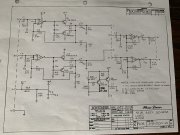BlueCrab
Journeyman
- Joined
- Nov 10, 2019
- Messages
- 230
So I sent this directly to Don, but decided to make it a thread instead.
I want to adjust the timing of the DCP. Currently the relay energizes in about 3 seconds (as designed). My PL4000 preamp does not output a signal for about 15 seconds, and then when it does, goes through a short 1-2 second transient where it outputs a 0.7 vdc signal. This is enough to trigger the DCP (and I'm glad it does!). So I'd like to delay the DCP for say 20 seconds to allow the PL4000 to do its transient thing and settle. Can I adjust the timing of the DCP to this longer period?
I want to adjust the timing of the DCP. Currently the relay energizes in about 3 seconds (as designed). My PL4000 preamp does not output a signal for about 15 seconds, and then when it does, goes through a short 1-2 second transient where it outputs a 0.7 vdc signal. This is enough to trigger the DCP (and I'm glad it does!). So I'd like to delay the DCP for say 20 seconds to allow the PL4000 to do its transient thing and settle. Can I adjust the timing of the DCP to this longer period?

